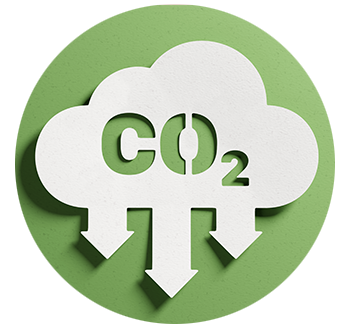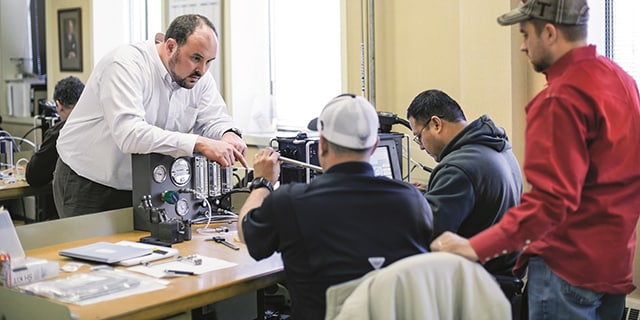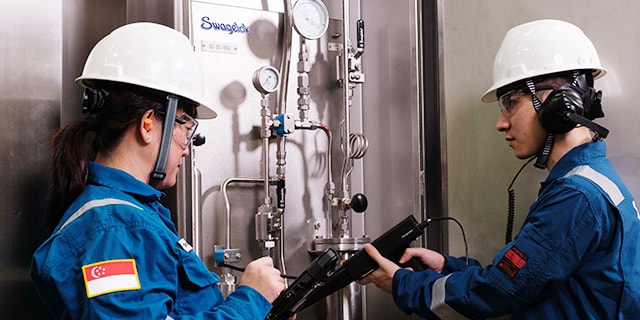What Industrial Trends are Affecting Fluid System Operators?

How to Adjust to Global Trends Affecting the Clean Energy, Semiconductor, Oil and Gas, and Chemicals Industries
Every day, global megatrends affect our businesses—whether we realize it or not. Staying aware of those trends and their potential impacts can help us make smarter decisions, regardless of the industry in which we operate. As we progress into 2024, we asked some of our commercial managers to tell us what challenges and opportunities shaped 2023 for industrial fluid system professionals and what that may mean for you in 2024. Here’s what we learned.
The Trend: Pandemic Fallout
Although the pandemic began easing in 2022 and officially ended in the first part of 2023, the market impact of it still lingers.
In the highly cyclical semiconductor market, which began 2023 riding a surge of unprecedented demand, a slowdown was anticipated. China’s near-total lockdown during the pandemic led to major supply chain disruptions, and as those were gradually overcome, high inflation and reduced consumer spending followed. As a result, the semiconductor industry slowdown came about sooner and has lasted longer than expected.
China’s struggles have also had a ripple effect: For example, scarcity of chips for clean energy vehicles has fueled a steep slowdown in the hydrogen market in China. The clean energy market is also seeing changing equipment demands driven by shifts in workforce demographics. Post-COVID, many heavy-duty truck drivers who were used to and preferred diesel engines have retired. The next generation of drivers are now having to adjust to using new CNG engines as the technology matures to match the power of a diesel engine.
In oil, gas, and chemicals markets, growth rates have been relatively steady. But even here, the pandemic-induced economic slowdown caused major disruption, with prices bottoming out and even turning negative before rebounding to pre-pandemic levels. The aftereffects of post-COVID turbulence also include ongoing supply chain issues and a shortage of skilled labor as workers retire and are not replaced. This has led many oil and gas companies to delay or not do their maintenance turnarounds.
The pandemic may be behind us, but some change it caused is here to stay. Here’s how our team recommends adjusting accordingly.
Our Team’s Advice

“To make sure they and their employees are prepared for major technology/equipment changes, companies should consider not only training opportunities, but also getting involved with relevant industry standards committees and trade associations to learn from peers.”
— Dan Niemiec, market manager for clean energy

“Leveraging external expertise is a good avenue for filling any voids in times of turmoil. This may mean thinking differently about suppliers who have not always been seen in the “partner” category—the relationships may be there, but there could also be opportunities to work together differently.”
— Scott Breaux, senior manager for strategic accounts

“Companies will also need to think completely differently about project planning. Instead of a sequence of finish-to-start tasks, ask yourself, ‘What’s the overall scope and what parts of it can be worked on in parallel?’”
— Trey Sinkfield, senior manager for engineering services
 The Trend: Geopolitical Disruptions
The Trend: Geopolitical Disruptions
Whether it was the war in Ukraine, trade issues between China and the West, or ongoing unrest in the Middle East, the geopolitical stage had a significant impact on markets in 2023. Disruptions in both supply chains and the relationships that underlie them has been a key outcome, and likely will continue to be for the foreseeable future. It’s led to governments investing more cautiously as they search for indicators of either growth or recession.
This environment of uncertainty has impacted both mature markets like oil, gas, and chemicals and emerging markets like clean energy and semiconductors. While some may have expected that rising energy costs and the war in Ukraine would favor clean energy development in Europe, for example, both of those factors also served to create instability and dampen investment in the region.
North America, meanwhile, has seen a much higher uptick in renewable natural gas and hydrogen business than many experts anticipated. Even before factoring in growth driven by the Inflation Reduction Act, significant investments were made in hydrogen that will impact the industry notably over the next 3-5 years.
Whether positive or negative, there is no lack of uncertainty, leading many companies to question, “How should we prepare to ride out this challenging time?”
Our Team’s Advice

“The companies that succeed amid turbulence will have open dialog with suppliers about forecasts and potential impacts of macroeconomic events to minimize supply chain disruptions.”
— Sara Ottaviano, market manager for semiconductor

“Many companies are working on contingencies to shift production based on current state and ‘what if’ scenarios. Navigating those scenarios will require a holistic approach that combines diversifying supply sources, conducting thorough risk assessments, engaging in diplomacy, investing in technology and innovation, implementing monitoring and early warning systems, and collaborating with industry peers.”— Scott Breaux
The Trend: Carbon Reduction
One of the biggest themes of 2023—and one that is likely to remain prominent for years to come—is the effort to meet the terms of the Paris Agreement, with its call for net-zero emissions by 2050. It has helped create a fundamental societal shift toward prioritizing environmental, social, and governance (ESG) initiatives, which have significant implications across markets.
In industries like oil, gas, and chemicals that deal regularly with hydrocarbons or semiconductor that uses a lot of energy and water, there’s significant pressure to show environmental impact reductions. But there’s not a lot of agreement on what that looks like. For example, one school of thought says that to get to net-zero emissions by 2050, we’ll need to hit peak oil in 2030. Another school says that would create a crisis, and we need to hit peak oil in 2045. These are major strategic issues that can have tremendous impact on suppliers, labor, and consumers in the years ahead.
To meet carbon reduction goals, companies are starting to shift focus from Scope 1 emissions––what they can handle internally––to Scope 2 (renewables and the types of fuel they use) and Scope 3, which focuses both downstream on how their fuels are used and upstream to their suppliers. That is leading to new ways of collaborating with those suppliers, and in some cases, a cascade of ESG compliance requests to validate compliance within a supply chain.
Aside from initiatives for operational efficiency and emissions reduction, many companies are looking at investment in low-carbon options like natural gas, carbon capture and storage (CCS), biofuels, and hydrogen that are adjacent to their core competency. More companies have recently started to develop biodiesel using organic materials to create an alternative to traditional diesel fuel and are working on making products like sustainable aviation fuel more widely commercially viable. Since a lot of the applications using these fuels are similar to those using traditional fuel, leak-free fluid system construction remains a priority.
While some see these carbon reduction-related changes as purely disruptive, our specialists agree that they also bring opportunity.
Our Team’s Advice

“Customers are taking advantage of fugitive emissions-reducing components as a starting point to make their fluid systems more sustainable, but they aren’t stopping there. As companies focus on carbon reduction, they may want to consider everything from leak detection services to flare and vent recovery—which can be useful for measuring and showing improvement on emissions.”
— Randy Rieken, market manager for oil, gas, and chemicals

“Thinking differently about the byproducts of their processes can lead to opportunities for companies to drive more sustainable operations. For example, hydrocarbons innately contain hydrogen, and if that can be captured, refineries can potentially be a source of hydrogen production. If they are familiar with operating systems containing hydrogen, though, the right fluid system design partner can help them make sure they are building systems that are safe, reliable, and compliant.”— Dan Niemiec

“A focus on ESG compliance can also lead to more cooperative customer-supplier relationships based on a common outlook on achieving ESG goals. Conversations are increasingly focused on the engineering behind a given fluid system component or subsystem and how it helps customers meet their environmental goals and support a people-focused organization.”— Sara Ottaviano
The Trend: Doing More with Less
A common challenge that all markets will face is the growing pressure to do what needs to be done more efficiently. Technology has been a benefit for companies everywhere facing this challenge. In recent years, advanced technology trends such as digitalization (including Industry 4.0 / Industrial Internet of Things) and artificial intelligence (AI) have helped improve efficiency. And now, generative AI promises immediate cost reduction, enhanced process efficiency through comprehensive data analysis, revenue expansion by optimizing resource exploration and recovery, and acceleration of innovation by facilitating rapid testing and development of new processes. Companies are even embracing it for expedited material production, reduced energy consumption, and enhanced overall efficiency, safety, and sustainability.
But AI won’t fix everything. Companies are also realizing they need to fill skills or capabilities gaps as employees retire or industry cycles make it challenging to find knowledgeable workers. For example, as semiconductor demand has tapered off but growth in advanced technologies remains a constant, many chip fabricators have shifted their focus from production to R&D to proactively find ways to responsibly meet the growing demand for data processing. But a key challenge is finding people with the right experience. There are pockets of semiconductor expertise around the country, but as the industry expands into other areas, meeting their labor force needs can be a big challenge. Companies are realizing they need to think differently about their relationships with business partners who may be able to provide needed expertise. They are also considering how they can build efficiencies into their interactions with those partners as their relationships grow.
Our Team’s Advice

“Fluid system professionals should look critically at their supplier relationships when trying to do more with less. That may mean relying on suppliers for support services instead of just products—embedding their engineers with relevant expertise alongside employees in the field, for example. It could also be simpler than that—figuring out how to make transactions flow more smoothly or asking for kitting of frequently used products to make ordering more efficient.”
“We’re also seeing a lot of focus on modularizing larger and larger pieces of the project during construction projects. Some refineries are making expansions by bringing in pre-fabricated units that are dropped in place and connected like pieces of a puzzle. Semiconductor is doing the same thing on a smaller scale, bringing in modules for specific functions. It streamlines and simplifies integration, and they know they’re getting tested, proven systems.”
— Trey Sinkfield

“As companies —especially semiconductor fabricators—build new facilities, they may struggle to find skilled technicians, engineers, and operational plant managers. The semiconductor industry is aware of this challenge and is working to fill labor gaps by investing in STEM-related programs to “grow” the future labor force. In the meantime, if they do not have expertise in all areas required to get the facility running effectively, their existing partners might. Collaboration is often the key to overcoming challenges.”— Sara Ottaviano
— Dan Niemiec“Finding the right expertise will be key for companies changing their focuses in the years ahead. As organizations from the oil and gas market get involved in new clean energy areas like hydrogen production and distribution, for instance, they are finding they don’t always have expertise in safely handling small-molecule gases. Finding the right training on component and material selection or consultation on systems engineering can help them succeed.”
“More oil, gas, and chemical companies are realizing the value of involving fluid system partners earlier during system design or facility construction projects. Sometimes, a company will build a facility according to plan and realize later that they have not optimized the facility for their fluid systems. Earlier collaboration can lead to better outcomes.”— Randy Reiken
Capitalize on Opportunity in 2024
In 2024, we will continue to see global megatrends impact our businesses. We can learn from the past, but we can’t anticipate everything. One thing is clear, however: Close, collaborative, mutually beneficial relationships between companies and suppliers can help everyone weather whatever may come our way. As Trey Sinkfield summarized it, “I don’t know how 2024 will play out, but I do know that we are excited to work alongside customers to support them in the journey—applying our fluid system expertise to help them overcome whatever challenges arise.”
The views and opinions expressed are those of the authors and is intended for informational purposes only.
Related Articles

How to Decarbonize and Cut Fugitive Emissions
Refineries and oil and gas facilities face an increasing need to reduce fugitive emissions throughout their facility. Learn the driving factors behind decarbonization and fugitive emissions reduction and strategies to do it.

Closing the Manufacturing Skills Gap
With an aging industrial workforce nearing retirement, manufacturers are turning to younger generations to replace expert knowledge. Learn how to build an effective fluid system training program with expert advice from Swagelok.

Four Ways Training and Advisory Services Can Help You Bridge the Skills Gap
Learn how fluid system training and advisory services can help operators bridge a growing skills gap across several industries.



